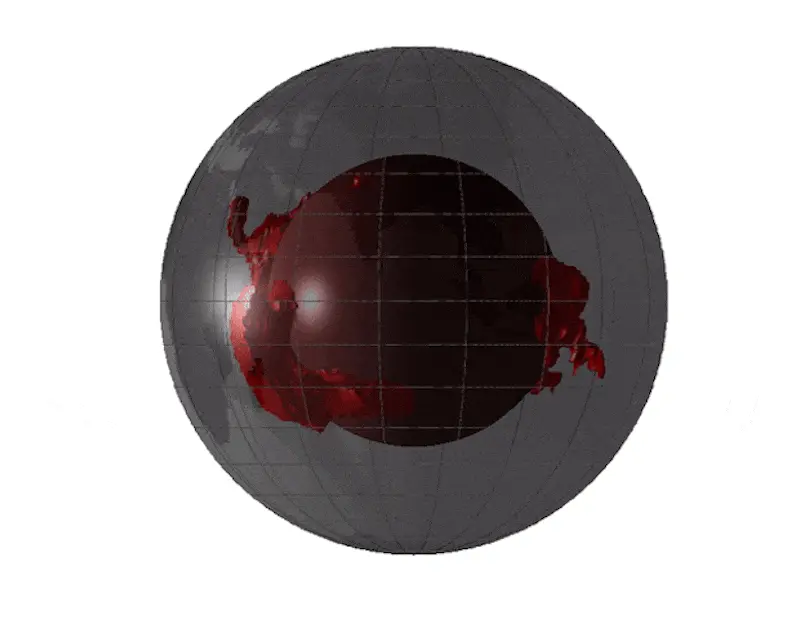
- Theia was a young, still-forming planet like Earth in the early solar system. Where did it originate?
- Theia and Earth experienced a massive collision about 4.5 billion years ago. The collision formed the moon and left traces of Theia in both the moon and Earth.
- New analysis of elements from that leftover material suggests that Theia originated closer to the sun in the inner solar system.
Theia and Earth: Neighbors in the early inner solar system?
The leading theory for how Earth got its moon is that the moon formed from a large rocky body – known as Theia – that collided with the early Earth about 4.5 billion years ago. But where did Theia come from? A team of researchers, led by the Max Planck Institute for Solar System Research (MPS) in Germany and the University of Chicago, said on November 20, 2025, that Theia likely originated closer to the sun than Earth. You could say that Theia and Earth were neighbors in the inner solar system before they smashed into each other.
It still isn’t known exactly how the collision occurred, but scientists said Theia was destroyed, with only traces of it still existing in the Earth and moon today.
The researchers published their peer-reviewed findings in the journal Science on November 20, 2025.
A massive collision 4.5 billion years ago
Around 4.5 billion years ago, a large rocky body collided with the young Earth. Scientists have named this body Theia. Earth’s moon was born from that chaos. And while scientists are confident this happened, they are still trying to determine specific details, such as the size and composition of Theia and how the impact affected the young Earth.
Theia itself was obliterated in the collision. But traces of it still remain in both Earth and the moon.
By tracking the isotopic fingerprints of iron in lunar and terrestrial rocks, researchers trying to understand the origin of Theia, the Moon’s mysterious progenitor, add evidence to the idea that it came from the inner Solar System. Learn more in Science: https://scim.ag/4oULoBk
— Science Magazine (@science.org) 2025-11-20T20:07:03.462523537Z
Isotopes provide clues
In the new study, researchers searched for clues to Theia’s composition and origin. They looked at the ratios of metal isotopes in rocks from both Earth and the moon. Basically, isotopes are variants of the same element that differ only in the number of neutrons in their atomic nucleus. They have the same number of protons and electrons, but different numbers of neutrons. This means there are also differences in the weight of the isotopes. The researchers explained that isotopes likely varied in the early solar system. So elements in the distant outer solar system had different isotope ratios than ones near the sun, for example.
The researchers were able to analyze the isotopes of iron in 15 rocks from Earth and six rocks from the moon with unprecedented precision. The moon rocks were those that the Apollo missions had brought back to Earth. The results showed the isotope ratios of all the rocks were quite similar. This was not unexpected, based on previous tests of moon rocks.

Reverse engineering Theia
How could the researchers determine the nature of Theia? They used reverse engineering, sort of. Reverse engineering uses deductive reasoning to try to understand how a device, process, system or piece of software works or accomplishes a task, with very little to no insight into exactly how it does so.
In this case, researchers used the similar isotopes in Earth and lunar rocks. Working backward, they tried to determine what the composition and size of Theia – and the composition of early Earth – were at the time of the collision.
To do so, they looked not only at the iron isotopes, but others as well. These included chromium, molybdenum and zirconium. This provided important clues as to how Earth and the moon ended up being the way they are today. As planetary scientist and geochemist Nicolas Dauphas at the University of Chicago and the University of Hong Kong explained:
These elements have different affinities for metal and therefore partition into planetary mantles in different proportions; this is why gold is so rare and precious! They give us access to different phases of planetary formation.
Iron and molybdenum were already present in Earth’s core, long before the collision with Theia. Later, those elements became absent in the mantle. But today, there is iron in Earth’s mantle. The researchers said this iron must have come from Theia. There is also zirconium, which didn’t sink into the core but instead remained in the mantle, until today.

The origin of Theia
All of this tells us more about Theia itself, but what abut its origin? The early Earth contained material from various different types of smaller rocky bodies. This happened as debris such as asteroids and other planetesimals – small rocky objects in the protoplanetary disks of young stars – collided together to form the larger planets, including Earth. By comparing the material from the early Earth with current known kinds of meteorites and asteroids, scientists can determine where different kinds of the material came from. This is also true for the material suspected to have come from Theia.
Analysis of the Theia material indicates it likely originated from closer to the sun than Earth. So Theia was essentially another rocky body like Earth, although maybe smaller. And it orbited closer to the sun, just as Venus and Mercury do today.
And then, somehow, Theia and the early Earth ended up smashing into each other. This not only formed the moon, but changed the course of Earth’s own history as well.
Bottom line: A new study suggests that Theia and Earth were neighbors in the early solar system about 4.5 billion years ago. Then their epic collision destroyed young Theia.
Source: The moon-forming impactor Theia originated from the inner solar system
Via Max Planck Institute for Solar System Research
Read more: Are 2 huge blobs inside Earth due to an ancient impact?











